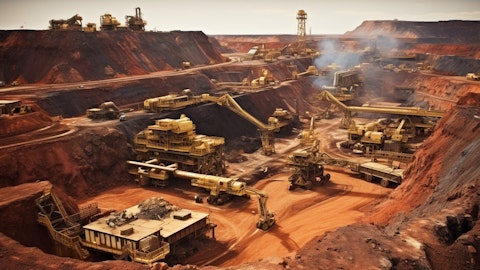Matt Greene: Hi, Matt Green from Goldman Sachs. Jakob on resolution, you mentioned you’re in the White House recently. Given we’re in an election year, do you believe that if we see a change of government, though you can see an acceleration of the polling and development timeline? And if I could just follow-up, Peter just on 2026 CapEx guidance on the yet to be sanctioned copper. Have you budgeted for Escondida at all? And with that deferral, does that free up some of the budget to perhaps accelerate other copper options within your portfolio?
Jakob Stausholm: Yes. So let me start. I just think that resolution will happen. We are making progress, good progress with the First Nation’s people. There are 11 tribes that claims connection to the land. We are making really, really good progress there, including with the San Carlos tribe. So that’s kind of a first thing, because even if you get approval from the government, we also need to have FPIC with the First Nation people. Then there is an approval process, which in the U.S. also goes through the courts and it’s in the Nine Circuits right now. And we’ll just have to respect that process. But leave no doubt that we are arguing our case. But I think we are arguing to an open door because it’s so much in the U.S. interest.
Critical minerals have never been more important. The U.S. right now is consuming 2 million tonnes of copper. It only produces one. It has only got two smelters left. One of them is ours in Kennecott, and we can load that up from copper in resolution. And the U.S. demand of copper because of the energy transition is likely to go from two to four. And there’s not a lot of copper production growing in the U.S. So I do think that it’s actually of national importance to develop it. So I’m very optimistic. The only thing I can’t give you is a timeline around it.
Peter Cunningham: And on Escondida, I mean, remembering the $3 billion when we talk about it, is for incremental copper equivalent units. So right across the portfolio. And so the Escondida numbers are embedded in our forward numbers, but not part of that $3 billion.
Menno Sanderse: And finally, Alex, ahead of your big conference on Monday, so be kind. Thanks.
Alex Pearce: Yes, so, Alex Pearce, BMO Capital Market.
Jakob Stausholm: Well, in fact, let me just have the tough questions now. So it’s going to be easy one on Monday.
Alex Pearce: This is an easy one. So on IOC you mentioned, actually you’ve got better volumes at the end of the year after a pretty challenging Q2, but it still seems to be running, at least from a guidance perspective, below the long-term target there. And it does seem like it’s infrastructure constrained. I just wondered, maybe you can comment on some of the initiatives you’ve got in place to try and meet that guidance that you’ve got this year. And also, can you just provide an update on some of the projects in terms of value add, I think HBI is being looked at et cetera.
Peter Cunningham: So Alex, I mean it was a tough year for IOC, but I mean, they did lose almost a month’s full production due to those wildfires. And that when you sort of take that into account, you can see that gives us more of a platform going into 2024 on production terms. So that’s the big piece. I mean, haulage, we had some constraints so we had a bit of extra inventory in IOC as well, just on the haulage because we had production actually very good or suddenly going right down. And so that made that whole system a bit unbalanced and we’re working through that. I mean, I think they are really sort of focused on the safe production system and working this through. I mean, there’s a big piece around asset integrity at IOC and a big piece around driving productivity through the integrated system to really get the most out of that.
I mean, I think on product I mean, it’s just that the product the IOC product is learn purity pellets, high-grade pellets I mean it will be in the world of sort of steel – green steel production that Jakob talked, I mean it’s right in the sort of middle section there for HBI production. I mean, it’s going to be a product in demand, and that’s where we want to position it.
Jakob Stausholm: Look, it is by any standard a disappointing production year last year from IOC. Maybe I’m too patient, but I am very patient because we are learning from these things, we have – that the asset had been on the block. We have not maintained it well for a long period of time. That takes time and the team is getting on, they’re getting more competencies and we just need to get better maintenance in place to make this stable. I would have loved to have seen it happening faster, but in a way, every time you have a setback with an issue, it’s has a negative short term impact. But it also has the opportunity for real learning and saying, how can we avoid that this ever happens again.
Menno Sanderse: Great. Thank you very much. Thank you everybody for coming very early this morning. Thank you for staying up late in Sydney and Melbourne. Jakob and Peter are looking forward to seeing many of you face-to-face in the next two weeks. For those we don’t see, see you in five months here again. Thank you.
Follow Rio Tinto Plc (NYSE:RIO)
Follow Rio Tinto Plc (NYSE:RIO)
Receive real-time insider trading and news alerts





